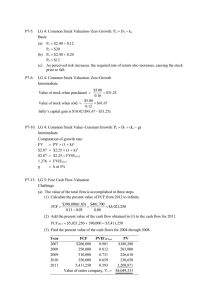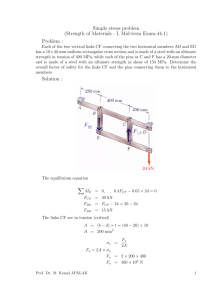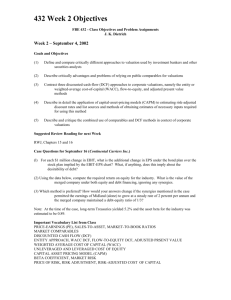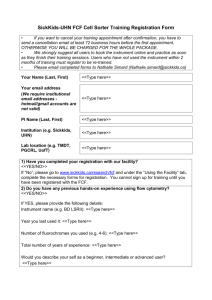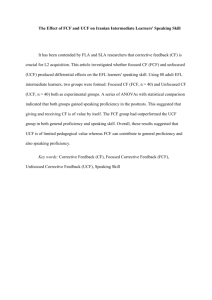How Platform Companies Work (Word doc)
advertisement
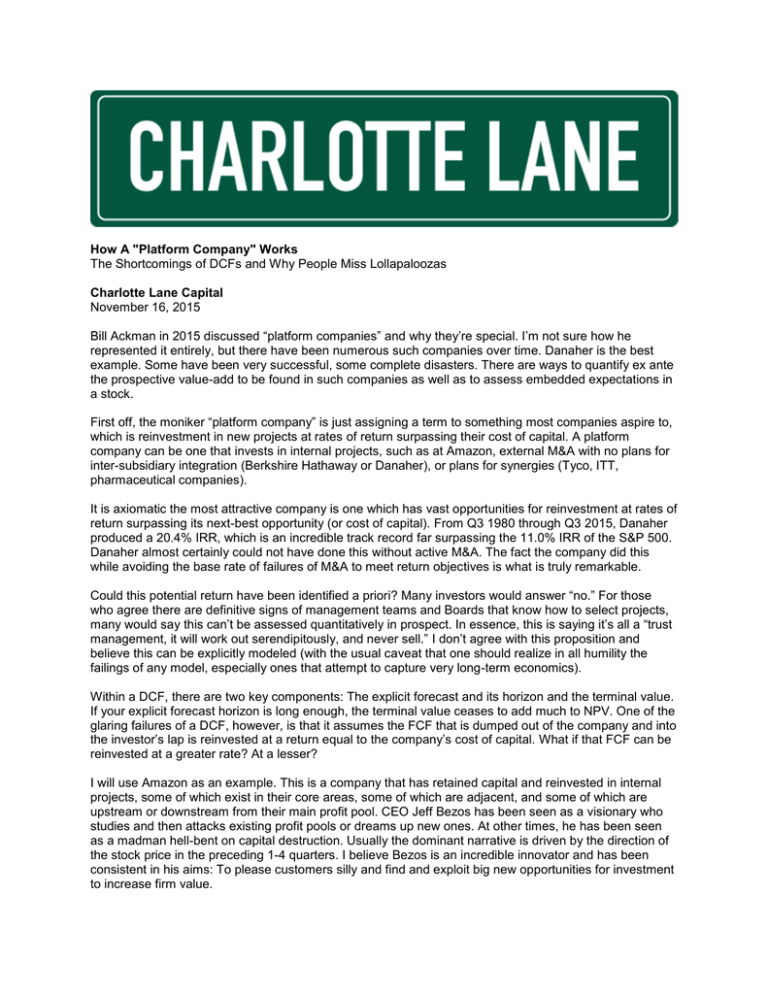
How A "Platform Company" Works The Shortcomings of DCFs and Why People Miss Lollapaloozas Charlotte Lane Capital November 16, 2015 Bill Ackman in 2015 discussed “platform companies” and why they’re special. I’m not sure how he represented it entirely, but there have been numerous such companies over time. Danaher is the best example. Some have been very successful, some complete disasters. There are ways to quantify ex ante the prospective value-add to be found in such companies as well as to assess embedded expectations in a stock. First off, the moniker “platform company” is just assigning a term to something most companies aspire to, which is reinvestment in new projects at rates of return surpassing their cost of capital. A platform company can be one that invests in internal projects, such as at Amazon, external M&A with no plans for inter-subsidiary integration (Berkshire Hathaway or Danaher), or plans for synergies (Tyco, ITT, pharmaceutical companies). It is axiomatic the most attractive company is one which has vast opportunities for reinvestment at rates of return surpassing its next-best opportunity (or cost of capital). From Q3 1980 through Q3 2015, Danaher produced a 20.4% IRR, which is an incredible track record far surpassing the 11.0% IRR of the S&P 500. Danaher almost certainly could not have done this without active M&A. The fact the company did this while avoiding the base rate of failures of M&A to meet return objectives is what is truly remarkable. Could this potential return have been identified a priori? Many investors would answer “no.” For those who agree there are definitive signs of management teams and Boards that know how to select projects, many would say this can’t be assessed quantitatively in prospect. In essence, this is saying it’s all a “trust management, it will work out serendipitously, and never sell.” I don’t agree with this proposition and believe this can be explicitly modeled (with the usual caveat that one should realize in all humility the failings of any model, especially ones that attempt to capture very long-term economics). Within a DCF, there are two key components: The explicit forecast and its horizon and the terminal value. If your explicit forecast horizon is long enough, the terminal value ceases to add much to NPV. One of the glaring failures of a DCF, however, is that it assumes the FCF that is dumped out of the company and into the investor’s lap is reinvested at a return equal to the company’s cost of capital. What if that FCF can be reinvested at a greater rate? At a lesser? I will use Amazon as an example. This is a company that has retained capital and reinvested in internal projects, some of which exist in their core areas, some of which are adjacent, and some of which are upstream or downstream from their main profit pool. CEO Jeff Bezos has been seen as a visionary who studies and then attacks existing profit pools or dreams up new ones. At other times, he has been seen as a madman hell-bent on capital destruction. Usually the dominant narrative is driven by the direction of the stock price in the preceding 1-4 quarters. I believe Bezos is an incredible innovator and has been consistent in his aims: To please customers silly and find and exploit big new opportunities for investment to increase firm value. I am not sure what’s so hard to figure out here and I have never been. I’ve never understood why Columbia professor Bruce Greenwald has such a problem with it and it was a pleasure to bring to light days after Ravi Suria put out his damning report on the company his three primary financial statements didn’t foot (through digging an equity hole via running investments in affiliates to a below-zero balance). Love the book or no, I thought Brad Stone’s The Everything Store: Jeff Bezos and the Age of Amazon captured very well all the positive elements I’ve long seen in this company and Bezos. For instance, many saw early the investment in Amazon Web Services as some sort of Quixotic adventure. I saw it as being akin to Ford’s River Rouge plant, which was perhaps the most verticallyintegrated large-scale manufacturing facility of the last century. Rather than outsource functions such as steelmaking and rubber vulcanization to highly consolidated suppliers who would dig their rents of out of Ford, the company insourced those functions. That allowed the company to control a key source of components, manufacture on a more just-in-time basis, control the strategic asset that would give it an operating edge, and either increase profits or use lower unit costs to beat its competitors into the ground. AWS is no different. It’s a key asset now and outsourcing it to Oracle or IBM doesn’t make much sense. The company doesn’t use it so much to drive all the profits it might otherwise choose to generate in selling AWS capacity on a merchant basis. It continually lowers price to drive down the learning curve. According to learning curve theory codified by Boston Consulting Group, the real cost of value-add declines at a 25-35% rate every time cumulative industry or firm experience doubles. Amazon understands this and tries to double its cumulative experience quickly as the pachyderms seek to protect their margins. This leaves those companies with higher returns on capital but zero embedded competitive advantage period; these are wonderful signatures of value traps. Meanwhile, Amazon defers the move up the ROIC curve but the market understands at various intervals there is NPV in what it’s doing and the duration of the competitive advantage it is forming is lengthy. There are lots of big words there, so let’s boil it down. NPV = current cash flows in steady state + present value of growth opportunities (PVGO). IBM’s value is found in the former (which I have my doubts about) and very little in the latter while the opposite is true in Amazon’s case. If we had more detailed management accounting, we could parse that more finely, but given what we know from Ks and Qs, that’s about the model that holds true currently. Which brings us back to the “platform company” concept. It’s all about reinvestment of cash flow (internally generated or capital raised externally). Now, in the Amazon model, I can take a guess at what their addressable market is based on historical precedent (in this case, the penetration overlays nicely with Wal-Mart’s experience) and then update as they add ventures (AWS, Amazon Prime Video). I will be the first person to say this guess is very loose. I will also add that I’m a mere mortal who can probably see less clearly the future opportunities Jeff Bezos can see. So the first order of business in using a 15+ year DCF for Amazon, or anything, is understanding there is no crystal ball. A DCF is a telescope that will point at a different galaxy if we move it 10 mm. Over a 15 year forecast horizon, my explicit DCF value is $414. This incorporates an average 12% revenue growth rate over this period with a 9.5% GAAP EBIT margin at maturity. Let’s leaving aside for a moment whether we agree on that – this discussion is headed elsewhere. As we see in cell BR25 of the “DCF” tab, I use a 11.4x NOPAT multiple in the terminal year 1. However, this is the FCF that I as a mere mortal can see. What if I’m Jeff Bezos and can find uses for all that FCF to yield 20% IRRs over that same forecast horizon? If we retain that FCF and do so, all else equal, the company would be worth $509 (cell BR31) in the “DCF” tab. The mechanism for modeling this is simple. The FCF the company spits out goes into an account and that account accretes value at a 20% I don’t count the build of negative working capital in the calculation of FCF, I deduct inflows from stock options, and I deduct implied capex for assets acquired through capital lease and finance lease transactions. 1 rate (or whatever rate the user chooses to use in line 27). Each year’s FCF gets added to that account and accretes from that point forward (be careful not to compound a negative value in this line, however). For the mathematical proof on whether this works, set line 27 equal to the “WACC” line (line 9 in the “DCF” tab). Line 333 is the check line and the two values, in the explicit DCF and the “reinvestment DCF” should equal within 10 bps or so. If this seems like a blue sky sort of tool, we can also use this tool to reverse engineer the reinvestment rate of return embedded in the stock price currently. I believe the stock price currently embeds a 32% IRR (for the period 2022—2030) for FCF reinvested in opportunities I don’t explicitly forecast. How reasonable is this? Well, look at Danaher or Berkshire over the years. It’s possible. But a low probability. Looking at Bezos’ track record, I’d say he has a higher probability of doing this than probably 485 of S&P 500 CEOs. Let’s also look at what happens when a company reinvests in bad projects. Entering (5%) for the period 2022-2030 in line 27 (“reinvestment rate”) yields a value of $352, or 15% below the explicit DCF value in cell BR25. Think of it this way – a healthy company is headed by a brain dead board and a yahoo for a CEO. They can’t help themselves and they take all the luscious cash flow produced by the good base business and put it in an account that loses 5% per year. Alternatively, let’s say the company can reinvest FCF at WACC every year except in one year. Let’s call it 2025. For that year, enter (100%) to signify the company allocating the prior year’s reinvestment account to $58B acquisition that totally blows up. They write it off, it generates zero value, and the company goes back to investing at WACC. The resulting value in cell BR31 is $361 – the company still killed $52 per share in value through one bad deal. This last scenario is what I always think of when a deep value investor says “Well, it’s at 10x earnings. It doesn’t need to grow and it’s good.” That presupposes zero growth is the lower boundary for fundamental outcomes. That is outrageously out of step with the base rate for all corporations and it ignores the fact that desperate corporations that fail to grow often act like rabid, cornered, wild animals. That’s when the bad M&A comes in. I’ve seen it, I’ve had investments do this, and I think any investor should be able to take into account such a scenario and have the capability to model it. Conclusions. 1. “Platform company” as a rubric is not new. Carnegie Steel, the Vanderbilt empire, Ford Motor Company, Amazon, and Danaher are all platform companies that have seen massive success. Valeant? We’ll see. 2. There is no reason to throw up our hands and claim this can’t be modeled, leaving it all up to serendipity. This can be modeled. 3. A DCF has a failing in that is assumes we can model with accuracy future FCF and every dollar of future FCF is then invested a rate of return neither exceeding nor falling short of WACC. We know, however, this happens all the time. This tool as offered as a way of way of producing a model with some verisimilitude with respect to the way platform companies create value and the way bad M&A destroys it. 4. To use this model productively, it helps to understand the base rate of success for “platform companies.” The rate of success is exceedingly low and an investor has to have a rock solid reason why they assume reinvestment success across a long-term forecast horizon. 5. Similarly, given M&A fails to achieve return targets 65% or more of the time, one should immediately model a sub-WACC outcome for M&A (using this tool or in some other way). 6. Zero growth should not in any way be the lower boundary for one’s fundamental assumptions in casting scenarios. 7. Hopefully this tool with help investors find a lollapalooza. After all, if you don’t go looking for a tenbagger, the chances one finds one decrease.

